Astorga...the small, monumental city
Thursday, September 30, 2021

Astorga is the place where two of Spain's most important cultural routes converge: the Way of Saint James and the Silver Route. With over 2,000 years of history, this city in Castile-León is home to a surprising monumental site, where Renaissance cathedrals and Roman baths jostle with the modernism of Gaudí.
To discover Astorga you have to head for the province of León, in northwestern Spain. It is located just 45 kilometres from the city of the same name, León, in a region known as La Maragatería. After being conquered by the Romans, the town became an important strategic centre, mainly on account of the area's wealth in deposits of gold. The heritage of that period and the remains of the mines themselves are some of the attractions you will find in Astorga, but not the only ones.


The first thing you will notice when you get to the town is the view of two of its most important monuments, Santa María Cathedral and the Episcopal Palace. The two buildings are set side by side and are surrounded by a Roman defensive wall which is in an excellent state of conservation. Take a close look, because the Cathedral is a beautiful synthesis of styles, with elements ranging from Florid Gothic to Baroque and Renaissance. This is because construction work began in the 15th century and was not completed until the 18th. Another unusual aspect is the difference in colour of the two towers that flank the main entrance - one of them was affected by an earthquake in 1775 and took longer to be finished. Inside, be sure to admire the stunning main altarpiece and choir stalls.
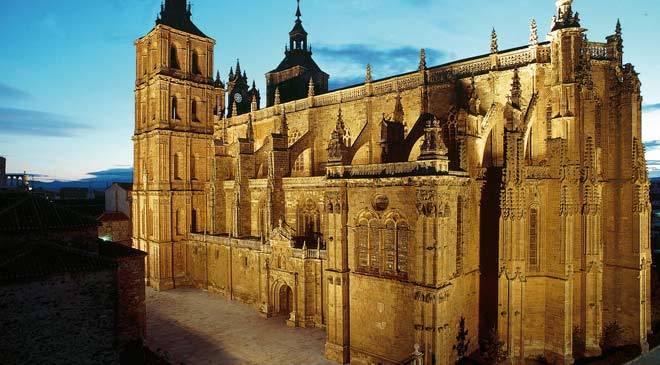
Beside the Cathedral is the Episcopal Palace, designed by the famous modernist architect Antonio Gaudí. It is a neo-gothic building that looks like something out of a fairy tale. In the garden outside you will be welcomed by three angels in zinc, and inside you can visit the Los Caminos Museum, which has an interesting collection of items related with the Way of Saint James. Astorga is home to other interesting buildings, such as Casa Granell House and San Andrés Church.
Next, head for Plaza Mayor Square where you will find the baroque Town Hall and a traditional street market held every Tuesday morning. A visit to the town's Roman remains is also not to be missed. You will find remains of the forum, thermal baths, "domus" (houses), the imperial temple, the camp of the legion and the drainage network. In the ancient Ergastula (prison) you will now find the Roman Museum with statues, amphorae, jewellery and reliefs. To make sure you see everything, it is best first to visit the town's Tourist Office.

If you have more time, head out to one of the surrounding villages and discover the charm and character of the traditional architecture of the La Maragatería region. Castrillo de los Polvazares, for example, just 5 kilometres from Astorga, is home to a good representation, and we would also recommend you try the typical dish of the region: maragato casserole. You can also do the “Gold Route”, that will take you to different villages around the region in search of ancient Roman mines. Be sure to make a stop to discover Astorga. You will be pleasantly surprised.
 0
Like
Published at 9:52 PM Comments (0)
0
Like
Published at 9:52 PM Comments (0)
The Oldest Synagogue in Europe
Tuesday, September 21, 2021

The Ancient Synagogue of Barcelona is located in the centre of the city. It is believed to be the oldest synagogue in Europe. Archaeological investigations show that the original structure of the building was built in the third or fourth century; whether this structure was the synagogue cannot be said with certainty. After many centuries of use for other purposes, the building was re-opened as a synagogue and museum in 2002. No congregation prays regularly at the Sinagoga Major, but it is used for festive occasions. The building was significantly expanded during the 13th century. Medieval Barcelona is known to have had several synagogues, and the main synagogue was certainly in the immediate area. King James, I visited the synagogue in 1263 at the conclusion of the Barcelona Disputation. Shlomo ben Aderet served as the rabbi of the Sinagoga Major for 50 years.
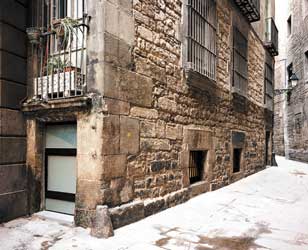 
It is believed that the original building was freestanding. To the north, it adjoined with what was then Escola Mayor Street and to the east with Marlet Street. The building ran southerly along “de Les Dones” Street, where, in the 19th century a narrow edifice was built. To the west, there was probably an atrium, the site where later, around the 17th century, the stairs to the present-day building were erected. In the northern exterior wall, there is an effigy of Santo Domingo. Emblematic buildings in the Jewish Quarters were Christianized with the effigy of a saint. The bloodiest day in the history of Barcelona’s Jewish community was August 5, 1391. On that day, the day celebrated as Santo Domingo, the Quarters were attacked.
 
After the uprising, the street name was changed to Sant Doménec. The building, along with all of the community’s belongings, passed into the hands of the king.
We find ourselves before a building whose foundations date back to Roman times. In addition, there are superimposed high-medieval constructions and a central structure from the 13th century. Also visible are 17th-century modifications made when the upper-level apartments were built.
At the end of 1995, the former owner put the property up for sale. The space was to be utilized as a bar. Before this lamentable eventuality, Mr Laffa decided to purchase the property with the hope of bringing to light its historic past and preserving it from use that would not dignify its extensive past.
Thus began the collaboration between Mr Riera and Mr Laffa, with a common objective: to salvage a significant period of Catalan history from oblivion through the rehabilitation of the former Major Synagogue space.

 3
Like
Published at 7:13 PM Comments (0)
3
Like
Published at 7:13 PM Comments (0)
Seville - One of the finest cities in Spain
Tuesday, September 7, 2021
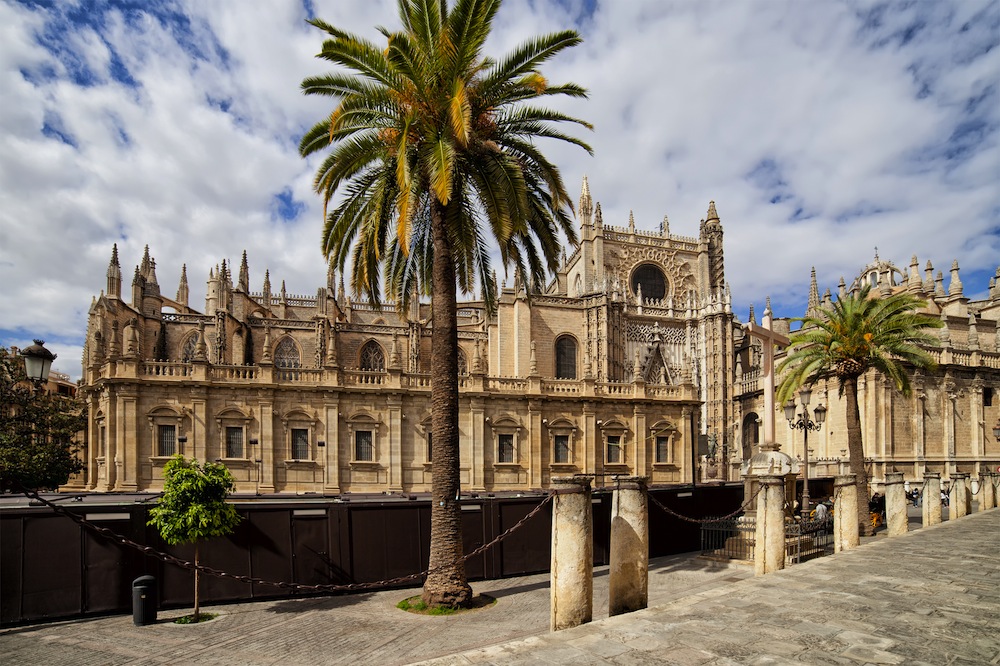
Seville is one of the most spectacular cities in Spain for architecture, a City that possesses an unparalleled wealth of history and art. Together the Cathedral, Alcázar (Arabian fort) and Archivo de Indias (The New World Trade Archive) form a remarkable monumental complex in the heart of Seville. They perfectly epitomize the Spanish "Golden Age", incorporating vestiges of Islamic culture, centuries of ecclesiastical power, royal sovereignty and the trading power that Spain acquired through its colonies in the New World.
Founded in 1403 on the site of a former mosque, the Cathedral, built in Gothic and Renaissance style, covers seven centuries of history. With its five naves it is the largest Gothic building in Europe. Its bell tower, the ‘Giralda’, was the former minaret of the mosque, a masterpiece of Almohad architecture and now is an important example of the cultural syncretism thanks to the top section of the tower, designed in the Renaissance period by Hernán Ruiz. Its "chapter house" is the first known example of the use of the elliptical floor plan in the western world. Ever since its creation, the Cathedral has continued to be used for religious purposes.
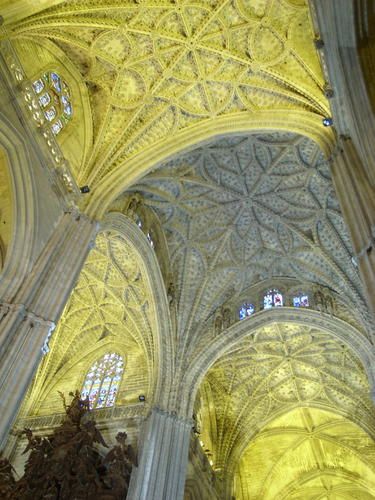 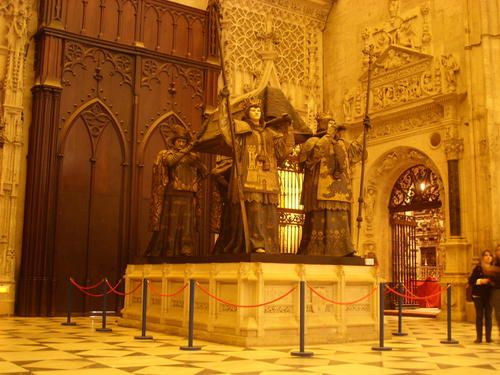
The original nucleus of the Alcázar was constructed in the 10th century as the palace of the Moslem governor, and is used even today as the Spanish royal family's residence in this city, thereby retaining the same purpose for which it was originally intended: as a residence of monarchs and heads of state. Built and rebuilt from the early Middle Ages right up to our times, it consists of a group of palatial buildings and extensive gardens. The Alcázar embraces a rare compendium of cultures where areas of the original Almohad palace - such as the "Patio del Yeso" or the "Jardines del Crucero" - coexist with the Palacio de Pedro I representing Spanish Mudejar art, together with other constructions displaying every cultural style from the Renaissance to the Neoclassical.
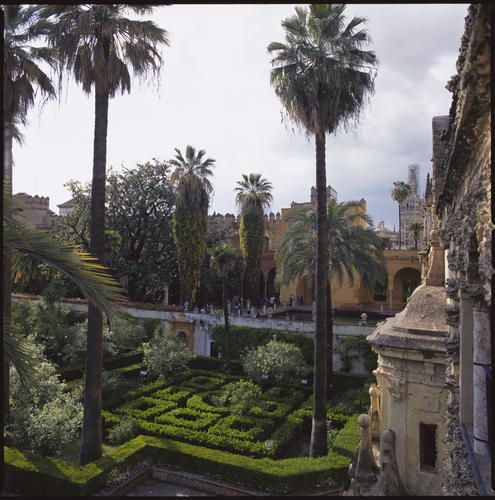
The Archivo de Indias building was constructed in 1585 to house the Casa Lonja or Consulado de Mercaderes de Sevilla (Consulate of the merchants of Seville). It became the Archivo General de Indias in 1785, and since then it has become home to the greatest collection of documentation concerning the discovery of and relations with the New World. The Archivo de Indias, designed by the architect responsible for completing El Escorial, Juan de Herrera, is one of the clearest examples of Spanish Renaissance architecture. An enormous influence on Baroque Andalusian architecture and on Spanish neoclassicism, it symbolizes the link between the Old and the New World.
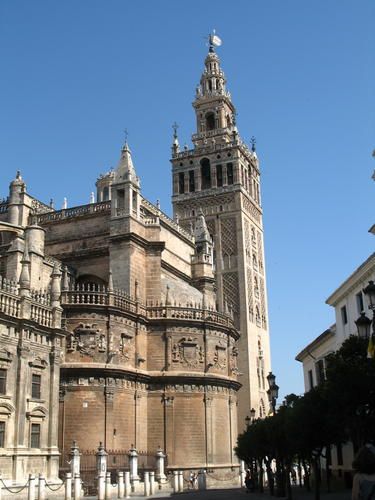
Seville owes its importance during the 16th and 17th centuries to its designation as the capital of the Carrera de Indias (the Indies route: the Spanish trading monopoly with Latin America). It was the "Gateway to the Indies" and the only trading port with the Indies from 1503 until 1718.
The Conjunto Monumental, or group of historic buildings encompassing the Cathedral/Giralda, the Alcázar and the Archivo de Indias, constitutes a remarkable testimony to the major stages of the city's urban history (Islamic, Christian, and that of Seville with its associations with the New World), as well as symbolizing a city that became the trading capital with the Indies for two centuries - a time during which Seville was the hub of the Spanish monarchy and played a major role in the colonization of Latin America following its discovery by Columbus.
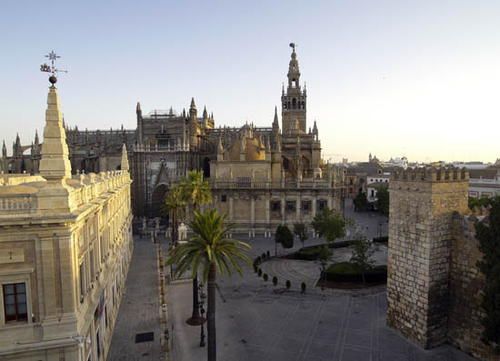
Each one of these monuments is associated with the colonization process. The tomb of Columbus is preserved in the Cathedral. The Sala de los Almirantes (Admirals' hall) in the Alcázar was the headquarters of the Casa de Contratación (House of Trade), from which the monopoly with the Indies operated, and where, as a seat of learning, it spawned some of the most important expeditions of exploration and discovery of that period. And the Archivo de Indias has, since the 18th century, housed the most valuable and important documents, which provide an insight into this historical event.
Ver mapa más grande
BEST TIME TO VISIT : ALL YEAR ... except maybe for August - too hot for most!
 0
Like
Published at 9:40 PM Comments (0)
0
Like
Published at 9:40 PM Comments (0)
Spam post or Abuse? Please let us know
|
|